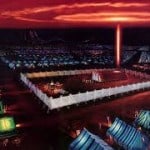We are told the following “They shall make for Me a Sanctuary, and I shall dwell amidst them.” The classic question points to the fact that it says “I shall dwell amidst them” rather than “amidst it” .the answer implies that the lessons and experience of the building of the Mishkan ( the tabernacle) will be revelatory and instructive in the process of bringing the Presence of Hashem into our lives.
When describing the construction of the Tabernacle , Hashem gives Moshe the necessary data and instructions regarding the construction of the Aron (Holy Ark), the Shulchan (Table), and the Menorah. After this, Moshe begins to transmit Hashem’s instructions regarding the construction of the surrounding Tabernacle itself.
Then G-d declares a sentence that hides more than it reveals; “And you shall erect the Mishkan according to its proper manner, as you will have been shown on the mountain” (Exodus 26:30) .
Clearly the order as it is described in this Torah portion is the ark, the vessels and then the encompassing tabernacle walls.
Yet when we read of Betzalel’s actual construction in the torah portion of “Pekudei” (Exodus 38:21 – 40:38) ,we see that the order of construction is reversed. Yet in spite of this seeming switch we continue to read ; “And Betzalel, son of Uri, son of Chur, of the tribe of Yehudah , did everything that Hashem commanded Moshe [regarding the construction of the Mishkan].” (Exodus 38:22)
Rashi on the words “everything Hashem commanded Moshe” teaches that Betzalel did everything as Hashem commanded , even intuiting the intended order of that construction. This perhaps is the meaning behind the verse;
“And you shall erect the Mishkan according to its proper manner, as you will have been shown on the mountain. “(ibid 26:30)
Moshe the teacher, in his description of the order of the construction was teaching about the essence and the purpose of it all.
Betzalel the artisan was giving that essence and purpose, expression in the physical world.
The midrash in the Talmud (Berakhot 55a) has Betzalel explaining “the normal way of the world is that a person first builds a house and only afterwards brings vessels into it” The “way of the world “ is to maintain focus on the vessel that will contain and house the spiritual essence.
That is the reason that this torah portion describing the building of the sanctuary for Hashem comes after last week’s portion which described the rules and regulations of correct conduct between man and man. Our sages point out that HaShem is clearly saying “don’t think of bringing me an offering if your hands are not clean.Do Not think of building me a sanctuary if you have destroyed the home, reputation or life of your fellow human being.”
In the words of the prophet Isaiah in chapter 1:15-17)
And when ye spread forth your hands, I will hide Mine eyes from you…Wash you, make you clean, put away the evil of your doings from before Mine eyes, cease to do evil; Learn to do well; seek justice, relieve the oppressed, judge the fatherless, plead for the widow.
Make the external vessel pure and worthy and then and only then fill it with meaning and purpose As the Kotzker teaches ““Where is God to be found?”, He asked. His answer was that “He is found in the place where He is given entry.”His Presence is only revealed in a place that makes appropriate room for Him.
There are communities of faith that believe that encounters from G-d arrive at the whim of the Divine. While that may be true most of the time, there is much preparatory work that needs to precede that encounter. There are those waiting to be touched by G-d in their lives. They wait opposed to being involved in making the changes in their lives that helps prepare them to become that vessel. May we all have the wisdom and courage to make the changes necessary in our lives to become those vessels. The time for the ultimate filling of the vessels is fast approaching.

